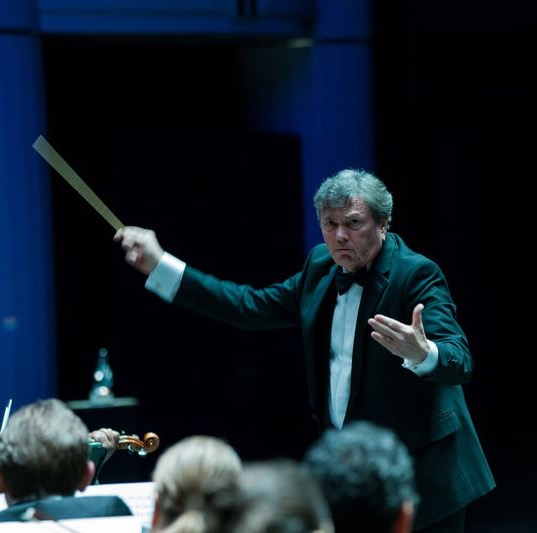Music vies with visuals in Frost Symphony concert at Arsht Center
The University of Miami’s Frost School of Music joined in the Art Basel celebration and Miami Art Week with “Pictures at an Exhibition,” a multi-media presentation of the Mussorgsky-Ravel orchestral staple, Saturday night at downtown Miami’s Arsht Center.
While the specially commissioned art and pieces from the Lowe Art Museum’s permanent collection projected on a large screen proved eye-filling, it was the performances by the Frost Symphony Orchestra under Gerard Schwarz that really commanded attention.
Fresh from an excellent all-Mozart concert with the Palm Beach Symphony two nights earlier, Schwarz opened the program with Julia Perry’s Short Piece for Orchestra. Astonishingly, this was the third local performance of Perry’s seven-minute score in less than five months. (Previous renditions were by the Miami Beach Music Festival Orchestra and the New World Symphony.)
Combining spiky harmonics and jumpy rhythms with arching lyricism, Perry’s work is the type of American music that Schwarz excels at. His taut reading was fully alive to sudden changes of meter and dynamics. Snappy brass and a violin solo of tonal warmth and agility by concertmaster Rosie Weiss highlighted a fine ensemble effort. It would be interesting to hear other works by Perry who projects a distinctive voice in this now oft-performed piece.
Jubilee Variations, the concert’s second work, is an authentic curio. In 1944, to celebrate the fiftieth anniversary of the Cincinnati Symphony Orchestra, the British conductor Eugene Goossens commissioned ten composers to each write a variation on a theme he had composed. The result is a 25-minute patchwork that works for three quarters of the way. Goossens’ theme is an invigorating neo-classical romp. Aaron Copland contributed an “Allegro brilliante” that could easily have come from one of his ballet scores, so unmistakable is the music’s rousing American ethos. (The audience applauded Copland’s spirited turn.) Howard Hanson’s austere brass fanfares recall his large-scale symphonies. A quiet, thematically memorable interlude from William Schuman and a bright, crackling Allegro by Walter Piston are samples of the craftsmanship of two of America’s finest composers. Roy Harris’ prairie Moderato and Paul Creston’s blues-infused Tranquillo also have their charms.
The big surprise is a large scale Andante by Deems Taylor. Once a major presence as a composer (who had two operas produced at the Met), music critic, author, commentator and broadcaster, Taylor is largely forgotten today. The full blown romanticism and rich melody of his variation suggests a revival of his music may be overdue.
In the final three sections and finale, Jubilee Variations goes off the rails. The obscure Anis Fuleihan’s Andante con moto sounds barely above the conservatory level – pseudo–Samuel Barber without the thematic inspiration. Bernard Rogers’ Animando is trite, vulgar dance music that was played with more precision and zest than it deserves. “Solenne” by the usually formidable Ernest Bloch emerges as a cross between a funeral cortege and film soundtrack.
All of which paves the way for Goossens’ thumping, overblown finale. Clearly the conductor was trying to outdo Elgar in his finale of the Enigma Variations yet Goossens lacked Elgar’s mastery, producing a loud, blatant conclusion which still excited a cheering audience. Schwarz has been a championing Goossens’ compilation (there is a YouTube video of him leading The Orchestra Now in the work.) He conveyed his enthusiasm for this strange concoction to the musicians whose playing was well disciplined and animated, particularly the highly exposed winds.
The music cum art iteration of Pictures at an Exhibition was the concert’s raison dêtre. Curated by the Lowe Museum’s Jill Deupi, the feast of multiple images during each movement was undeniably engrossing and entertaining. However, it relegated Ravel’s symphonic reimagining of Mussorgsky’s piano suite to the background which was doubly unfortunate.
There have been many orchestral versions of the work since the first by Mikhail Tushmalov in 1886 but Ravel’s has proven durable and for good reason. Ravel was a master of orchestral color and he imbued Mussorgsky’s daunting virtuoso challenge with luminous instrumental hues and brilliant contrasts that suggest a new, thoroughly reconceived score. Schwarz led his student forces in a reading that would have been a credit to an orchestra at any major conservatory.
The clear articulation of the trumpet in the initial “Promenade” prefaced a musically intelligent and coherent traversal. (Omar Ba’s images for the “Promenade” and its repetitions and the work of abstract painter Mikhail Larionov were among those most appropriate to the music presented.) Some conductors opt for extremely fast or very slow tempos in this gleaming instrumental canvas. Schwarz took a middle ground, concentrating on expressive character and transparency of individual timbres, drawing a big sonority from the corporate ensemble.
“Gnomus” was given concentrated intensity while Mia Laping’s saxophone solo in “The Old Castle” was phrased in curving musical lines with subtle shading. There was energy to spare in the skittering figurations of “Tuileries” and Schwarz brought edgy tension to the confrontation of “Samuel Goldenberg and Schumyle.”
For the final “Great Gate at Kiev,” the brass’s corporate blend was mellow rather than harsh and the central orthodox chant subtle and understated. Throughout the performance, the seven basses and two harps were clearly present and the gong smacks at the climax had palpable impact. Schwarz and the hard-working players brought the sound pictures to vivid life without need of any visual embodiment.
Gerard Schwarz conducts the Frost Symphony Orchestra in Strauss’s Don Juan, Ravel’s Bolero, Debussy’s La Mer and Chausson’s Poème with a student competition winner as violin soloist 7:30 p.m. February 12, 2022 at UM Gusman Concert Hall in Coral Gables.
Posted in Performances
Leave a Comment
Sun Dec 5, 2021
at 12:47 pm
No Comments







